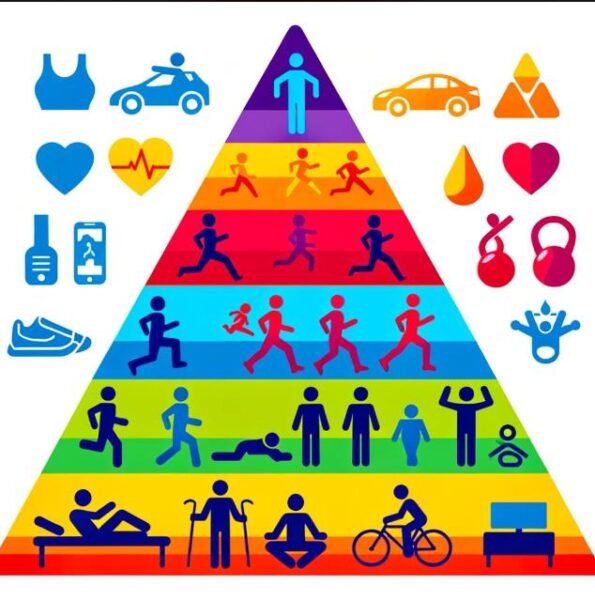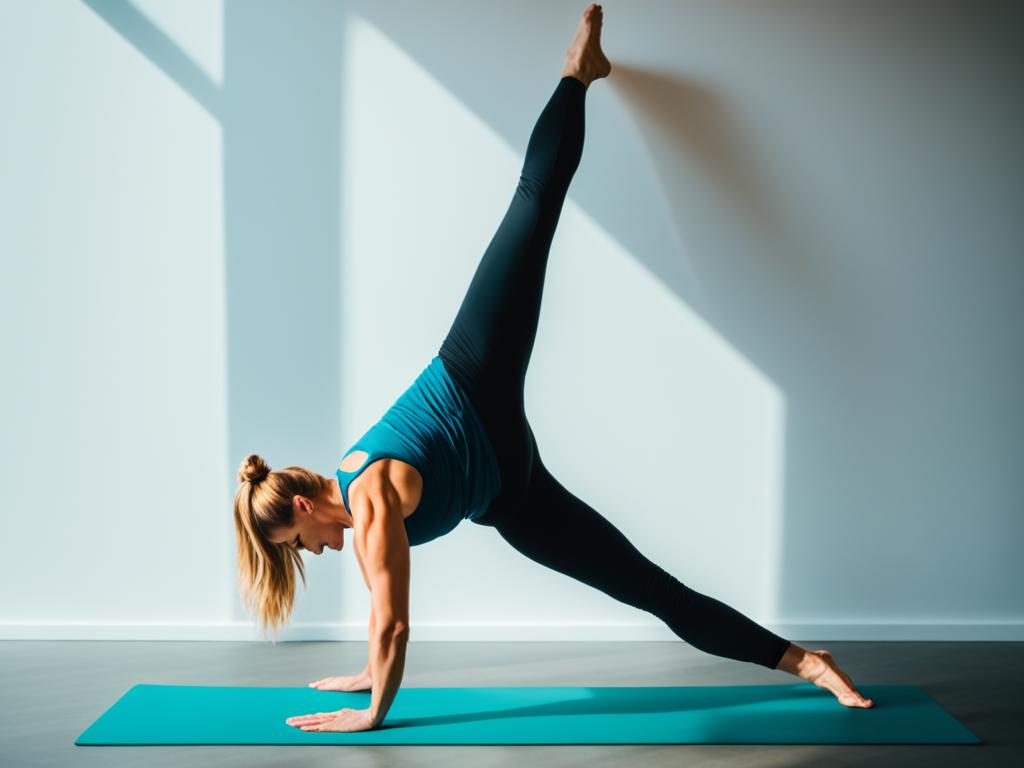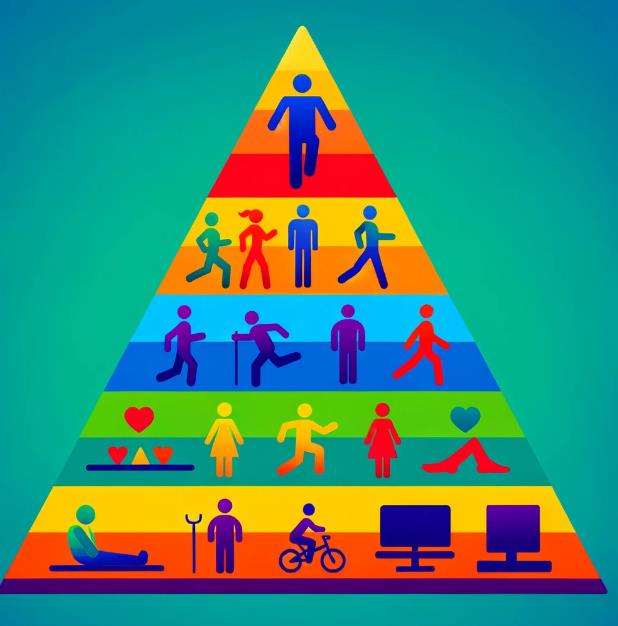When it comes to physical activity, we often associate it with structured exercises or intense workouts. But what about the everyday activities we do without even thinking about it? Where do these lifestyle activities fit within the Physical Activity Pyramid? Are they even considered as important as traditional forms of exercise?
Well, the truth is that lifestyle activities hold a significant place on the pyramid, right at its base. They may not be high-intensity exercises, but they play a crucial role in promoting overall health and wellness. These activities include walking or biking to work, taking the stairs instead of the elevator, doing household chores, and participating in recreational activities with friends or family.
So, why should we pay attention to lifestyle activities and where exactly do they belong on the Physical Activity Pyramid? Let’s delve deeper and explore the benefits and importance of incorporating these activities into our daily routines.
Key Takeaways
- Lifestyle activities are an important part of the Physical Activity Pyramid.
- They may not be high-intensity exercises but have significant benefits for overall health and wellness.
- Examples of lifestyle activities include walking or biking to work, doing household chores, and engaging in recreational activities.
- Lifestyle activities contribute to daily movement, calorie expenditure, cardiovascular health, muscle strength, and mental well-being.
- By incorporating lifestyle activities into our routines, we can create a balanced approach to physical activity that aligns with the recommendations of the Physical Activity Pyramid.
Where on the Physical Activity Pyramid Do Lifestyle Activities Belong?
Lifestyle activities belong at Bottom Level – Level 1 of the Physical Activity Pyramid. This level includes everyday activities. Let’s delve and find out more!
Understanding the Physical Activity Pyramid
The Physical Activity Pyramid is a graphical representation of different levels of physical activities and their recommended frequencies. It is designed to help individuals understand the hierarchy of exercises and make informed choices about their daily movement. The pyramid consists of four levels: level 1 includes everyday activities, level 2 focuses on aerobic and recreational activities, level 3 emphasizes leisure, flexibility, and strength activities, and level 4 represents sedentary activities. Understanding the pyramid can assist in creating a well-rounded fitness routine and achieving optimal health and wellness goals.

Physical Activity Pyramid
| Level | Category |
|---|---|
| Level 1 | Everyday Activities |
| Level 2 | Aerobic and Recreational Activities |
| Level 3 | Leisure, Flexibility, and Strength Activities |
| Level 4 | Sedentary Activities |
The Physical Activity Pyramid provides a clear representation of the different types of activities and their hierarchy. At the base of the pyramid, level 1 includes everyday activities that can be easily incorporated into our daily routines. This includes activities like walking, taking the stairs instead of the elevator, and doing household chores. Moving up the pyramid, level 2 emphasizes aerobic and recreational activities that promote cardiovascular health and endurance. Examples of level 2 activities include brisk walking, cycling, and swimming.
Level 3 of the pyramid focuses on leisure activities, flexibility training, and strength activities. These activities improve flexibility, muscle strength, and overall mobility. Leisure activities can include activities like golf and recreational sports, while flexibility training involves activities like stretching and yoga. Strength activities can range from weightlifting to using resistance bands.
Lastly, level 4 of the pyramid represents sedentary activities, which should be limited as much as possible. Prolonged periods of sitting or inactivity can have negative effects on our health and wellbeing. It is important to minimize sedentary behavior and incorporate more movement into our daily lives.
By understanding the Physical Activity Pyramid and its different levels, we can create a well-rounded fitness routine that includes a variety of activities. This ensures that we are meeting recommended guidelines for physical activity and taking steps towards a healthier lifestyle.
Level 1 – Everyday Activity
Level 1 of the Physical Activity Pyramid comprises everyday activities that can be easily incorporated into your daily routine. These activities are aimed at reducing sedentary behavior and increasing overall movement throughout the day. Examples of level 1 activities include:
- Taking short walks or standing breaks every 20-30 minutes
- Walking or biking to nearby destinations instead of driving
- Gardening or doing yard work
- Intentionally incorporating extra steps into your day
Level 1 activities focus on active living and can significantly contribute to improved health and wellness.
The Benefits of Level 1 – Everyday Activity
Engaging in level 1 activities on a regular basis offers numerous benefits for your health and well-being. These activities promote active living and help you incorporate daily movement into your routine. Some of the benefits of level 1 activities include:
| Benefits | Description |
|---|---|
| Increased Physical Activity | Level 1 activities provide an opportunity to reduce sedentary behavior and increase overall movement throughout the day. |
| Improved Cardiovascular Health | Regular engagement in level 1 activities, such as walking or biking, can contribute to improved cardiovascular health and reduced risk of heart disease. |
| Enhanced Weight Management | Everyday activities like gardening and incorporating extra steps into your day can help with weight management and calorie expenditure. |
| Stress Reduction | Level 1 activities provide an opportunity to take short breaks, get some fresh air, and reduce stress levels, promoting mental well-being. |
By incorporating level 1 activities into your daily routine, you can promote active living, boost your overall health and wellness, and take a positive step toward a more active lifestyle.
Level 2 – Aerobic and Recreational Activity
Level 2 of the Physical Activity Pyramid focuses on aerobic and recreational activities that promote cardiovascular health and overall fitness. These activities are performed at a moderate to vigorous intensity level, elevating the heart rate and providing numerous health benefits. Engaging in level 2 activities, such as brisk walking, cycling, swimming, jogging, aerobics classes, and dancing, can have a positive impact on your well-being.
Aerobic activities, also known as cardiovascular exercises, work large muscle groups and increase oxygen consumption, enhancing heart and lung function. These activities are essential for maintaining a healthy weight, improving stamina, and reducing the risk of chronic diseases. Regular aerobic activity helps strengthen the cardiovascular system, allowing the heart to pump more efficiently and improving blood circulation throughout the body.
Recreational activities, on the other hand, provide a fun and enjoyable way to stay active and engage with others. From playing team sports to hiking or dancing with friends, recreational activities offer a wide range of options to suit different interests and fitness levels. Participating in recreational activities not only contributes to physical fitness but also positively impacts mental well-being, reducing stress and promoting a sense of joy and fulfillment.
By incorporating level 2 activities into your fitness routine, you can achieve the recommended amount of aerobic exercise while enjoying recreational pursuits. These activities form an integral part of the fitness pyramid, helping you establish a balanced approach to physical activity and leading a healthy lifestyle. Let’s take a closer look at some of the health benefits associated with level 2 activities:
| Health Benefits of Level 2 Activities: |
|---|
| Improved heart and lung function |
| Increased stamina and endurance |
| Weight management and calorie expenditure |
| Enhanced overall fitness levels |

Level 3 – Leisure, Flexibility, and Strength Activity
Level 3 of the Physical Activity Pyramid focuses on leisure activities, flexibility training, and strength training. These activities contribute to overall health and well-being by promoting mobility, flexibility, and muscular strength.
Leisure Activities
Leisure activities involve moderate-intensity movements that keep you active without necessarily raising your heart rate significantly. These activities provide an enjoyable way to stay physically active while engaging in recreational pursuits or daily tasks. Examples of level 3 leisure activities include:
| Activity | Description |
|---|---|
| Golf | A sport that involves walking and swinging a club, promoting cardiovascular fitness and coordination. |
| Recreational sports | Engaging in activities such as tennis, basketball, or soccer with friends or family. |
| Housework | Tasks like cleaning, gardening, or mowing the lawn that contribute to physical movement and energy expenditure. |
| Leisurely walking | Taking relaxed walks in nature or around your neighborhood to enjoy the outdoors and boost overall well-being. |
Participating in these leisure activities not only provides physical benefits but also enhances mental relaxation and social interaction.
Flexibility Training
Flexibility training involves exercises that improve muscle range of motion and joint flexibility. Incorporating flexibility exercises into your routine can help prevent injuries, reduce muscle stiffness, and enhance overall physical performance. Some examples of flexibility exercises include:
- Stretching exercises
- Yoga
- Pilates
By regularly performing flexibility exercises, you can maintain or improve your mobility, making it easier to perform daily activities and reducing the risk of muscle imbalances or joint issues.
Strength Training
Strength training activities involve resistance exercises that target specific muscle groups, promoting muscle strength, endurance, and overall functional fitness. By challenging your muscles, strength training helps improve bone density, muscle tone, and metabolism. Some examples of strength training exercises include:
- Lifting weights
- Using resistance bands
- Bodyweight exercises
Strength training not only helps build muscle mass but also supports joint stability, enhances posture, and promotes overall physical resilience.

Incorporating leisure activities, flexibility training, and strength training into your physical activity routine can bring numerous health benefits and contribute to a well-rounded and enjoyable fitness regimen.
Level 4 – Sedentary Activity
Level 4 of the Physical Activity Pyramid focuses on sedentary activities, which involve prolonged sitting or stationary behavior. These activities, such as watching TV, using the computer, or sitting for extended periods without movement, contribute to a sedentary lifestyle that can have negative impacts on health.
Excessive sedentary behavior has been linked to various health risks, including obesity, cardiovascular disease, diabetes, and certain cancers. Spending too much time in sedentary activities can lead to weight gain, increased risk of chronic diseases, and reduced overall fitness.
To mitigate the health risks associated with sedentary behavior, it is important to make conscious efforts to reduce the amount of time spent in sedentary activities. Incorporating regular breaks for movement, such as stretching or short walks, can help break up periods of sitting and promote blood circulation and muscle activity.
Additionally, finding opportunities to incorporate physical activity into daily routines can help counteract the effects of a sedentary lifestyle. Taking the stairs instead of the elevator, going for a walk during lunch breaks, or using a standing desk can all contribute to reducing sedentary behavior and promoting overall health.

Sedentary Behavior and Health Risks
| Health Risks | Description |
|---|---|
| Obesity | Sedentary behavior is a key contributor to obesity as it decreases calorie expenditure and promotes weight gain. |
| Cardiovascular Disease | Excessive sitting has been associated with an increased risk of developing cardiovascular diseases, including heart disease and stroke. |
| Diabetes | Engaging in sedentary activities for prolonged periods decreases insulin sensitivity and increases the risk of developing type 2 diabetes. |
| Cancer | Sedentary behavior has been linked to an increased risk of certain cancers, including colon, breast, and endometrial cancer. |
By being mindful of sedentary activities and actively reducing sedentary behavior, individuals can minimize health risks and improve overall well-being. Incorporating regular physical activity and movement into daily routines is essential for maintaining optimal health and avoiding the negative consequences of a sedentary lifestyle.
The Importance of Lifestyle Activities
Lifestyle activities are not only enjoyable but also play a crucial role in promoting overall health and well-being. These activities, incorporated into your daily routine, provide an opportunity for regular movement, contributing to calorie expenditure and helping maintain a healthy weight. The benefits of lifestyle activities extend beyond physical fitness, positively impacting various aspects of your health.
Improved Cardiovascular Health
Engaging in lifestyle activities, such as walking, gardening, or cycling, can have a positive impact on your cardiovascular system. Regular physical activity helps strengthen your heart and improves blood circulation, reducing the risk of cardiovascular diseases like heart attack and stroke. By incorporating lifestyle activities into your routine, you can enhance your cardiovascular health and maintain a strong heart.
Stronger Muscles and Bones
Lifestyle activities involve movements that engage your muscles and promote their strength and endurance. Activities like carrying groceries, doing household chores, or playing with your children or pets can contribute to building stronger muscles. Additionally, participating in weight-bearing lifestyle activities, such as walking or dancing, helps improve bone density, reducing the risk of osteoporosis and fractures.
Enhanced Flexibility
Incorporating lifestyle activities that involve stretching movements, such as yoga, pilates or gardening, can improve flexibility and joint mobility. Flexibility training helps maintain muscles’ elasticity and range of motion, reducing the risk of injuries and enhancing overall physical performance. By regularly engaging in these activities, you can enjoy increased flexibility and ease of movement in your daily life.
Boosted Mental Well-being
Participating in lifestyle activities provides numerous mental health benefits. Regular physical activity, even in the form of moderate-intensity activities, has been shown to promote the release of endorphins, brain chemicals that help improve mood and reduce stress and anxiety. Lifestyle activities also offer a chance to unwind, connect with nature, and engage in mindfulness, enhancing mental well-being and promoting a positive outlook on life.
Create a Balanced Approach to Physical Activity
By incorporating lifestyle activities into your routine, you can create a well-rounded approach to physical activity that aligns with the recommendations of the Physical Activity Pyramid. Lifestyle activities complement higher-intensity exercises by providing opportunities for daily movement and contributing to overall fitness and well-being. These activities are accessible to people of all ages and fitness levels, making them an excellent choice for maintaining an active and healthy lifestyle.
So, go ahead and find ways to incorporate lifestyle activities into your daily routine! From taking a brisk walk during your lunch break to dancing while cooking dinner, every little bit counts. Embrace the importance of lifestyle activities and enjoy the numerous health benefits they bring.
Conclusion
The Physical Activity Pyramid serves as a comprehensive guide to achieving optimal health and wellness through regular physical activity. At the foundation of the pyramid are lifestyle activities, which are incorporated into daily routines and provide a solid basis for maintaining an active lifestyle. By engaging in lifestyle activities, such as walking or biking to work, taking the stairs instead of the elevator, doing household chores, or enjoying recreational activities with friends and family, individuals can incorporate daily movement into their lives.
However, lifestyle activities are just the beginning. To fully enhance overall fitness and well-being, it is important to incorporate a variety of activities from higher levels of the Physical Activity Pyramid. Aerobic and recreational activities, such as brisk walking, cycling, swimming, or dancing, provide cardiovascular benefits and improve stamina. Leisure activities, flexibility training, and strength training also play essential roles in maintaining a balanced health and wellness routine.
By combining lifestyle activities with these higher-intensity exercises, individuals can create a well-rounded fitness routine that supports their health goals. Remember, consistency is key. Engaging in daily movement, whether through lifestyle activities or more intense exercises, can have a profound impact on physical and mental well-being. So, make a commitment to prioritize daily movement and use the Physical Activity Pyramid as a roadmap to guide your journey towards a healthier and more active lifestyle.

